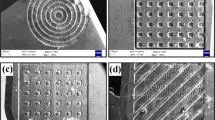Abstract
Super duplex stainless steels are extremely corrosion-resistant alloys designed for very demanding applications that expose them to corrosive environments, such as seawater. Due to their chemical composition and microstructure, which provide high mechanical strength and thermal resistance as well as high ductility, the machinability of these alloys is generally poor, resulting in long production cycles and high tooling costs. Moreover, machining may be harmful for the corrosion resistance of the alloy. The goal of this research is to study the turning operation of UNS 32750 alloy, known commercially as SAF 2507, and its influence on the alloy’s corrosion resistance in practical applications. Tests were performed, using cutting speed and cooling conditions with low and high fluid pressure as the input variables. The results indicate that turning with PVD-coated inserts under high-pressure cooling resulted in long tool lives, good workpiece roughness and high corrosion resistance of the material after machining. The most frequent wear mechanism found during the tests was notch wear, while the main tool wear mechanism was attrition.














Similar content being viewed by others
References
Chater J (2010) The European market for duplex stainless steels. Duplex Steel World, pp 1–5. http://www.stainless-steel-world.net
Bordinassi EC, Stipkovic Filho M, Batalha FG, Delijaicov S, Lima NB (2006) Superficial integrity analysis in a super-duplex stainless steel after turning. J Achiev Mater Manuf Eng 18:335–338
Sandvik Coromant (1996) Stainless steel turning—application guide. AB Sandvik Coromant, Sandviken, p 14
Paro J, Hänniken H, Kauppinen V (2001) Tool wear and machinability of HIPed P/M and conventional cast duplex stainless steels. Wear 249:279–284
Sandvik Coromant (2010) High pressure coolant machining. AB Sandvik Coromant, Sandviken, pp 1–47
International Molybdenum Association—IMOA (2009) Practical guidelines for the fabrication of duplex stainless steels, 2nd edn. International Molybdenum Association, London, p 32
Korkut I, Kasap M, Ciftci I, Seker U (2004) Determination of optimum cutting parameters during machining of AISI 304 austenitic stainless steel. Mater Design 25:303–305
Biermann D, Heilmann M (2010) Burrs—analysis control and removal. In: Aurich JC, Dornfeld D (eds) Burrs—analysis, control and removal. Springer, Berlin, pp 13–20
Hassiots ND, Petropoulos GP (2006) Influence of surface roughness on corrosion resistance of turned carbon steel parts. Int J Mach Mach Mater 1(2):202–212
Bramam C, Ben Rhouma A, Lédion J, Sidhom H (2005) Effect of machining conditions on residual stress corrosion cracking of 316L SS. Mater Sci Forum 490–491:305–310
Gravalos MT, Martins M, Diniz AE, Mei PR (2010) Influence of roughness on the pitting corrosion resistance of turned super austenitic stainless steel. Rev Escola de Minas 63:77–82
Shaw MC (1984) Metal cutting principles, 1st edn. Oxford Series on Advanced Manufacturing, New York, pp 292–332
Kaminski J, Alvelid B (2000) Temperature reduction in the cutting zone in water-jet assisted turning. J Mater Process Technol 106(1–3):68–73
Crafoord R, Kaminski J, Lagerberg S, Ljungkrona O, Wretland A (1999) Chip control in tube turning using a high pressure water jet. Proc Inst Mech Eng Part B J Eng Manuf 213(B8):761–767
Rasch FO, Vigeland T (1981) Hydraulic chip breaking. CIRP Proc 30(1):333–335
Sorby K, Tønnessen K, Torjusen JE, Andersen L (2008) Efeito da refrigeração a alta pressão na integridade superficial do Ti6Al4V. Rev Máquinas e Metais 511:40–55
Sandvik Materials Technology (2008) Duplex stainless steels—Sandvik SAF 2507. Sandvik Materials Technology, Sandviken, p 1
Sandivk Coromant (2009) Catálogo principal. AB Sandvik Coromant, Sandviken, pp A424–A433
American Society for Testing Material (ASTM) (2009) Standard test methods for pitting and crevice corrosion resistance of stainless steels and related alloys by use of ferric chloride solution 1—ASTM G48-A standard test method. ASTM International, West Conshohocken, pp 1–11
Trent EM, Wright PK (2000) Metal cutting, 4th edn. Butterworth-Heinemann, Woburn, pp 195–199
Diniz AE, Marcondes FC, Coppini NL (2006) Tecnologia da Usinagem dos Materiais, 5th edn. Artliber Editora Ltda, São Paulo, pp 124–129
Montgomery DC (1997) Design and analysis of experiments, 4th edn. Wiley, New York
Acknowledgments
The authors wish to thank Sandvik Coromant (Brazil) for the tools supplied for the experiments and also for support during execution of the tests and analysis of the results.
Author information
Authors and Affiliations
Corresponding author
Additional information
Technical Editor: Alexandre Mendes Abrao.
Rights and permissions
About this article
Cite this article
de Oliveira Junior, C.A., Diniz, A.E. & Bertazzoli, R. Correlating tool wear, surface roughness and corrosion resistance in the turning process of super duplex stainless steel. J Braz. Soc. Mech. Sci. Eng. 36, 775–785 (2014). https://doi.org/10.1007/s40430-013-0119-6
Received:
Accepted:
Published:
Issue Date:
DOI: https://doi.org/10.1007/s40430-013-0119-6




